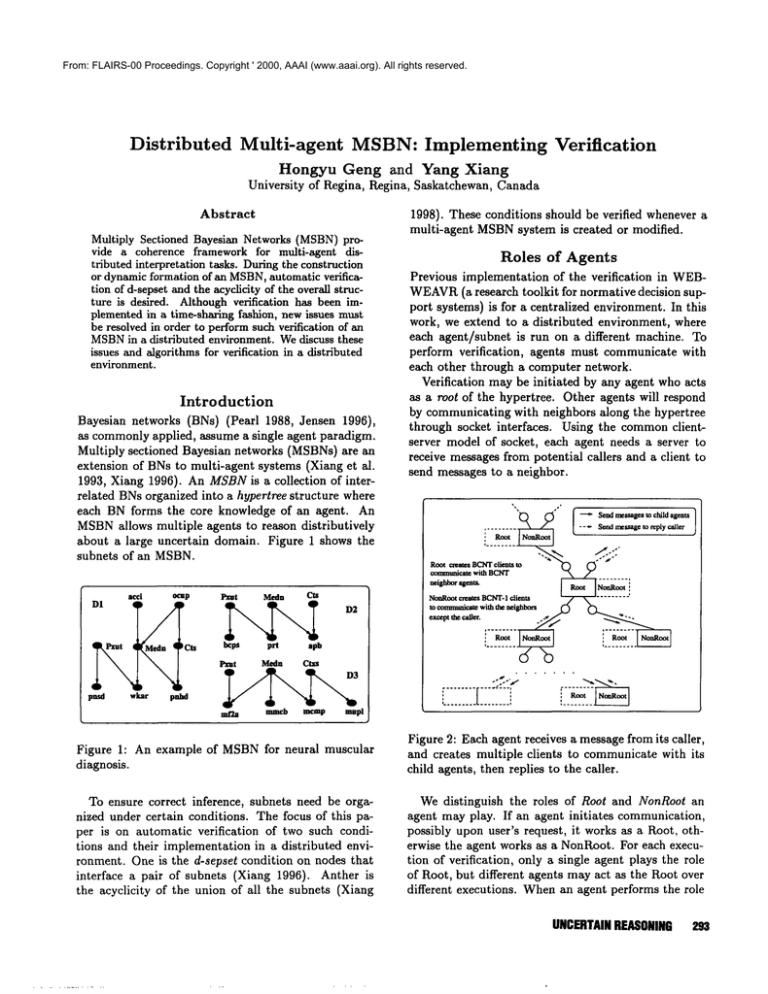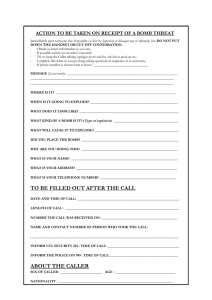
From: FLAIRS-00 Proceedings. Copyright ' 2000, AAAI (www.aaai.org). All rights reserved.
Distributed
Multi-agent
MSBN: Implementing
Verification
Hongyu
Geng and Yang Xiang
University of Regina, Regina, Saskatchewan, Canada
Abstract
Multiply Sectioned Bayesian Networks (MSBN)provide a coherence framework for multi-agent distributed interpretation tasks. Duringthe construction
or dynamicformation of an MSBN,
automatic verification of d-sepset and the acyclicity of the overall structure is desired. Althoughverification has been implementedin a time-sharing fashion, new issues must
be resolved in order to performsuch verification of an
MSBN
in a distributed environment. Wediscuss these
issues and algorithmsfor verification in a distributed
environment.
Introduction
Bayesian networks (BNs) (Pearl 1988, Jensen 1996),
as commonlyapplied, assume a single agent paradigm.
Multiply sectioned Bayesian networks (MSBNs)are
extension of BNsto multi-agent systems (Xiang et al.
1993, Xiang 1996). An MSBNis a collection of interrelated BNsorganized into a hypertree structure where
each BNforms the core knowledge of an agent. An
MSBN
allows multiple agents to reason distributively
about a large uncertain domain. Figure 1 shows the
subnets of an MSBN.
I)2
1998). These conditions should be verified whenever
multi-agent MSBN
system is created or modified.
Roles of Agents
Previous implementation of the verification in WEBWEAVR
(a research toolkit for normative decision support systems) is for a centralized environment. In this
work, we extend to a distributed environment, where
each agent/subnet is run on a different machine. To
perform verification,
agents must communicate with
each other through a computer network.
Verification may be initiated by any agent who acts
as a root of the hypertree. Other agents will respond
by communicating with neighbors along the hypertree
through socket interfaces. Using the commonclientserver model of socket, each agent needs a server to
receive messagesfrom potential callers and a client to
send messages to a neighbor.
"" [ ~ Send racssagcs
to child agents
""
Rootcre~s BCNT
clients to
cormnunicate
with BCNT
neighbor
agents.
~
~
NonRc~t
crcntcs BCNT-1
clients
to communicate
withthe neighbors
(~
........
I RootINdoor
::’
~ .........
~
i._~’..
IN°~°°’I
d"o
ml’2a
mmcb
memp
mupl
i_..x_.oo.,
..I No~oo,
J
illliiii[::::i:::i
........
Figure 1: An example of MSBNfor neural muscular
diagnosis.
Figure 2: Each agent receives a messagefrom its caller,
and creates multiple clients to communicatewith its
child agents, then replies to the caller.
To ensure correct inference, subnets need be organized under certain conditions. The focus of this paper is on automatic verification of two such conditions and their implementation in a distributed environment. One is the d-sepset condition on nodes that
interface a pair of subnets (Xiang 1996). Anther
the acyclicity of the union of all the subnets (Xiang
Wedistinguish the roles of Root and NonRoot an
agent may play. If an agent initiates communication,
possibly upon user’s request, it works as a Root, otherwise the agent works as a NonKoot.For each execution of verification, only a single agent plays the role
of Root, but different agents may act as the Root over
different executions. Whenan agent performs the role
UNCERTAIN
REASONING 293
of a NonRoot, there is another neighbor agent, acting
as either Root or NonRoot, which requests communication with this agent. Wecall the requesting agent
a "caller". A NonRootagent must reply to its caller
after it finishes its actions. Figure 2 illustrates these
two roles.
Verify
d-sepset
The d-sepset condition (Xiang 1996) ensures that variables shared by two subnets can pass relevant information at all cases. It prevents a shared variable to
have non-shared parents that are split into two subnets. The d-sepset between each pair of DAGsof the
MSBN
in Figure 1 is {Medn, Cts, Pxut). The verification is performed by the TestDsepset algorithm which
calls the algorithm CollectPalnfo.
Algorithm 2 (TestDsepset)
/~ test if all sepset are d-sepsets. */
input: caller index
begin
set flag = true;
union sepsets with all neighbor agents;
for each sepnode x in the union with a child agent
collect out-parent info of x locally;
if this agent is a leaf agent
if outcnt > I
flag =false;
el8e
for each child agent
create a messageclient to request the child
agent to perform CollectPalnfo to collect
parent info of x;
add the result from each child to outcnt;
if outcnt > 1
Algorithm 1 (CollectPaInfo)
flag = false;
/* collect a given variable’s parents information */
if
flag = true
input: caller index, a given variable v
for each child agent
begin
create a messageclient to request the
collect v’s parent information locally (result is outcnO;
child agent to perform TestDsepset;
if this agent is not a leaf agent
and
each result from each child with flag;
for each child agent
return
flag;
create a messageclient to request the child to
end
perform CollectPalnfo ;
add result from each child agent to outcnt;
return outcnt;
end
CollectPalnfo collects parent information outcnt of
a given variable v. First, the host agent performs an
operation locally to get the parent information of v in
itself. If v has out-parents (parent nodes not in any
sepset) locally, then outcnt = 1. Otherwise, outcnt =
0. Second, the host agent requests all child agents to
get the parent information of v in each child agent.
Finally, the result from each child agent is added to
outcnt and then outcnt is returned. As a result, if
outcnt > 1, then the given variable v has at least two
out-parents, each of which belongs to a different agent.
TestDsepset verifies if all subnet interfaces are dsepsets. For any sepnode, if its out-parents exist in
more than one agent, then the sepset which contains
this sepnodeis not a d-sepset. Initially, the host agent
collects the parent information of a sepnode v which
is in the union of all intersections with all of the child
agents. If the outcnt of a sepnode v is larger than 1,
then the out-parents of v exist in more than one agent.
Consequently, the sepset with the sepnode v is not a dsepset and there is no need to continue. The flag is set
to be false. Otherwise, if all the sepnodes in the union
294
FLAIRS-2000
have out-parents in only one agent, the host agent will
request each child agent to perform TestDsepset. The
result from each child agent will be "anded" with the
flag. Finally, the value of flag is returned.
Verify Acyclicity
The union of all DAGsin a MSBN
should be acyclic.
Xiang (1998) presents a set of operations to verify the
acyclicity. Here we reinterpret these operations under
a distributed setting. A node in a directed graph is a
root if it has no parent, otherwise a leaf if it has no
child. Verification is based on node marking. If the
union is acyclic, all nodes can be marked one by one
as root or leaf. Otherwise, nodes which form a cycle
are left unmarkedas the end.
Four operations, PreProcess, MarkNode, MarkedAil,
and TestAcyclicity, collectively verify acyclicity.
WhenPreProcess is performed, the host agent only
marks the root or leaf non-d-sepset nodes, and then
asks each child agent to do the same.
The family information of a variable in CollectFamilyInfo refers to the position of the node corresponding to the variable in the graph which consists of all
subnets. Whenthis algorithm is performed, host agent
will collect the family information of the given variable
Algorithm
3 (PreProcess)
Input: caller index
begin
mark non-d-sepset nodes that are root or leaf.
if it has child agents
for each child agent
create a messageclient to request the child
perform PreProcess;
end
Algorithm 4 (CollectFamilyInfo)
/* collect the family information of the given variable */I
Input: caller index, variable name v.
begin
collect v’s family info locally;
if this agent is not a leaf agent
if node v is a root node or leaf node
for each child agent
create a messageclient to request the child
to perform CollectFamilylnfo;
handle v’s family info with the collect result from
each child agent;
return v’s family info;
end
v locally. Then, host agent will request its child agents
to collect the family information of v if v is a root node
or leaf node locally. Host agent will handle the result
from each child agent with the local information and
return the final result to its caller.
Algorithm
5 (DistributeMarkNode)
//~ caller is always a neighbor agent ~//
Input: caller index, variable name v.
begin
if v is a d-sepset node of host agent
mark the given d-sepset node v locally;
mark all non-d-sepset root node and leaf node;
if this agent is not a leaf agent
for each child agent
create a messageclient to request the child
agent to perform DistributeMarkNode;
end
WhenDistributeMarkNode is performed, host agent
will mark the given variable v. Newroot nodes and
new leaf nodes might be produced because of the marking of v. Therefore, host agent will mark the new nond-sepset root node and leaf node. If this host agent
is not a leaf agent, it will request its child agents to
perform DistributeMarkNode.
MarkNodecan be called by the system or the neighbor agents. First, markCount, a counter, is set to
Algorithm
6 (MarkNode)
/* mark each node when possible ~/
Input: caller index.
Output: markCount-the number of d-sepnodes marked
in the last round.
begin
markCount--- O;
union d-sepsets with all neighbors;
for each unmarked d-sepnode x in the union
if x is a d-sepnodewith caller
continue;
call CollectFamilylnfo to collect the family
information of x;
if x is neither root node nor leaf node
continue;
else/* x is a root or leaf in the system */I
markCount ++;
DistributeMarkNode is performed;
for each child agent
create a messageclient to request the child agent
to perform MarkNode;
add the result from each agent to markCount;
return markCount;
end
count how many nodes will be marked after MarkNode is performed. Second, the d-sepsets with all neighbor agents except the caller are unioned. Third, for
each unmarked d-sepnode v in the union, host agent
performs CollectFamilyInfo to collect the family information of v. Fourth, if v is a root node or leaf node
in the system, DistributeMarkNode is performed and
markCountis incremented by one. Finally, if this host
agent is not a leaf agent, it will send a message to
each child agent, requesting each child agent to perform MarkNode. Each child agent will reply to the
host agent with its markCount value.
Algorithm
7 (MarkedAll)
/* Check if there is any local/remote node unmarked. ~/
Input: caller index.
begin
flag = true;
if there is local node unmarked,flag = false;
else if this agent is a leaf agent, flag -- true;
else send a message to each child agent
to request each child to perform MarkedAll;
process the flag with the result from each child;
return flag;
end
WhenMarkedAll is performed, the host agent first
sets flag to be true; If there is any unmarked node
UNCERTAIN
REASONING295
locally, then flag = false, and host agent will reply
to its caller with the value "false". Otherwise, it will
request its child agents to perform MarkedAll. If any
one child replies to it with a "false" value, the flag of
the host agent is false. Finally, host agent will reply to
its caller with the value of its flag.
Implementation
Both verification and inference in a distributed multiagent MSBNrequires communication among agents.
Wedesigned a generic framework such that some modules can be reused and other modules only need to be
modified slightly for different functions.
..........................................
Algorithm 8 (TestAcyelicity)
/*Host agent test if there is a cycle in the union of all
subnets in the system. */
Input: caller index, message type
begin
/* PreProcess phase */
if msgType == PREPROCESS
agent perform PreProcess;
/* MarkNode phase */
else if msgType == MARKNODE
do { /* NonRoot only performs one round *//
agent perform MarkNodeand return a value
of markCount;
if this agent is not a Root agent
markCount = O;
} while (markCount != 0};
/* MarkedAU phase */
else if msgType --= MARKEDALL
agent performs MarkedAll;
end
The top-level algorithm TestAcyclicity combines the
others to verify the acyclicity, msgTypehere stands for
the type of message that the host agent receives from
its caller. The host agent can be called by system or
one of its neighbor agents to perform this algorithm.
This algorithm is performed differently by an agent
depending on whether this agent acts as a l~oot or
NonRoot. The differences are two-folded. Firstly, if
the host agent is a Root, the system will call the host
agent to perform the three phases of the algorithm,
PreProcess, MarkNodeand MarkedAll, sequentially to
perform this algorithm. Otherwise, the host agent will
perform one phase of the algorithm once according to
the message type. Secondly, when MarkNode phase
is performed, l:toot will repeatedly perform MarkNode
until there is no nodes to be markedin the last round
(markCount = 0). NonRoot agent will only perform
MarkNodefor one round when it receives the request
and will return the value of markCountto its caller.
The complexity of TestAcyclicity is polynomial on
the numberofsubnets as well as the size of each subnet
(Xiang 1998). Our distributed
implementation does
not increase it.
296
FLAIRS-2000
,
Agent
,.’. MsgClient
:)
Jl
¯ " .......
tA
:
’,
,:.~Cnent)
’. ..............................
_’2:::::." ....
Figure 3: Each agent has a Courier and an AgentActions.
(~)
(~
AetAtPtMsg
Msk~FoChild
® M~,FmCtm
® A~tC~
Figure 4: Each agent has six actions. Two(in dotted
cycles) are performed by Courier, and the other by
AgentActions.
Each agent has a Courier and an AgentActions, and
can create multiple MsgClients when needed. Courier
is responsible for receiving from caller and replying (if
this agent is not Root) after the agent performs some
actions according to the message type and the protocol. Courier is reused in all functions which involve
communication. AgentActions perform four sequential
actions after the Courier receives a message from the
caller. If the agent is not a leaf in the hypertree, it creates multiple clients. Each client corresponds to one
child agent and is called MsgClient, to communicate
with one child agent. Figure 3 shows the structure.
Figure 4 shows the flow of a host agent’s actions.
Courier has two actions, MsgFmParent and MsgToParent. MsgFmParent performs an action which receives messages from the caller and processes the messages. MsgToParent performs an action to reply to
Figure 5: Four sequential actions of an agent. A leaf agent only has the first action.
the caller after the host agent performs some other
actions. The four sequential actions of AgentActions,
which are ActAtPtMsg, MsgToChild, MsgFmChild and
ActAtCdMsg, are performed after the host agent receives a message from the caller (that is, after MsgFmParent is performed.). ActAtPtMsg is the action
that an agent takes after it receives message from its
caller. MsgToChild is an action which prepares messages for child agents and creates multiple clients to
communicate with child agents. MsgFmChildis an action which waits for messagesfrom all child agents and
processes the messages it receives. The agent performs
ActAtCdMsgafter receiving reply from all child agents.
If an agent works as Root, it replies to no one and
MsgToParent is not performed. If an agent is a leaf
agent, it has no child agent and MsgToChild and MsgFmChildare not performed. Otherwise, an agent perform all six actions.
A special operation is performed in each action according to the type of the message it receives from
its caller. For example, if the message type is "PREPROCESS",then operation of ActAtParent is to mark
all the non-d-sepnodes which are leaf nodes or root
nodes locally. The operation of MsgToChildis to set
message type for each message and to create multiple MsgClients to communicatewith all child agents.
The operation of MsgFmChildis to wait for the reply from each child agent. Because PreProcess does
not need to do anything after the agent receives reply from each child agent, the agent will not perform
the last action-ActAtChild. Figure 5 shows an agent’s
sequential actions and the content of each action.
This frameworkcan not only be used in the verification of MSBN,but also in other operations in a multiagent MSBN.For instance, we can implement triangulation or inference in a similar manner. Courier, AgentActions MsgClient can be used directly. What we need
to change are the content in each action. Inference in
distributed
MSBNis thus implemented (Geng & Xiang 1998). Therefore, this design provides a unified
framework for implementing all operations of MSBN
including Verification, Triangulation, and Inference.
Conclusions
This paper discusses implementation of verification in
distributed multi-agent MSBNs.Wepresent a generic
framework for implementing similar operations which
requires communication among agents. Wehave tested
the implementation experimentally. One limitation of
the implementation is that when more than one agent
try to initiate verification simultaneously, the system
may not function correctly. Future research is needed
to resolve the issue.
References
[1] Geng,H., and Xiang, Y. 1999. Implementationof Fully
Distributed Inference in Multi-agent MSBN
Systems.
In Proc. IEEE CanadianConf. on Electrical and Computer Engineering, 1698-1703, Edmonton.
[2] Jensen, F. V. 1996. An Introduction to Bayesian Networks, NewYork: Springer.
[3] Pearl, J. 1988. Probabilistic Reasoningin Intelligent
Systems: Networksof Plausible Inference, Los Altos,
CA: Morgan Kaufmarm.
[4] Stubbs, D. F. and Webre, N. W. 1987. Data Structures
with Abstract Data Types and Modula-LPacific Grovce,
CA: Brooks/Cole.
[5] Xiang, Y., Poole, D. and Beddoes,M.P. 1993. Multiply
Sectioned Bayesian Networksand Junction forests for
Large Knowledge-BasedSystems. ComputationalIntelligence. 9(2): 171-220.
[6] Xiang, Y. 1996. A Probabilistic Frameworkfor Cooperative Multi-agent Distributed Interpretation and
Optimizationof Communication.
Artificial Intelligence,
(87): 295-342.
[7] Xiang, Y. 1998. Verification of DAGStructures in Cooperative Belief NetworkBased Multi-agent Systems.
Networks, 31: 183-191.
UNCERTAIN
REASONING 297







